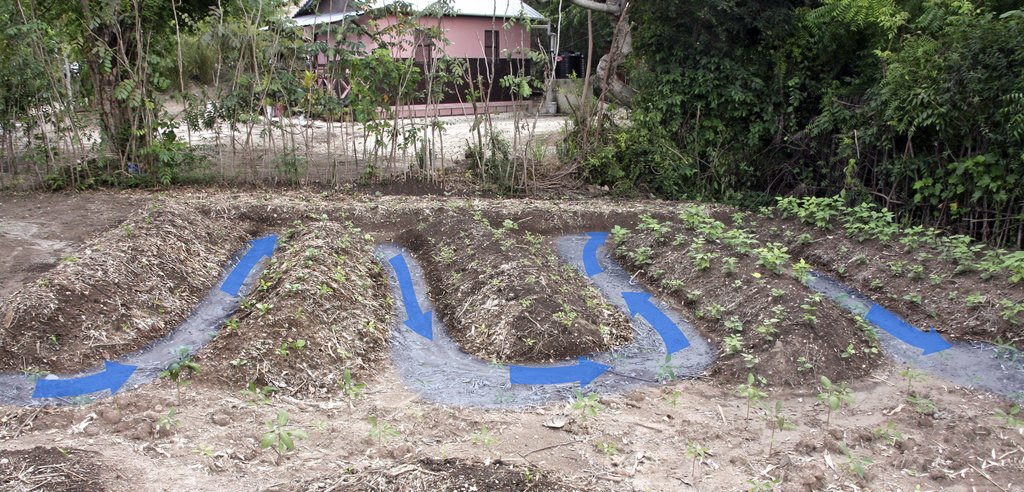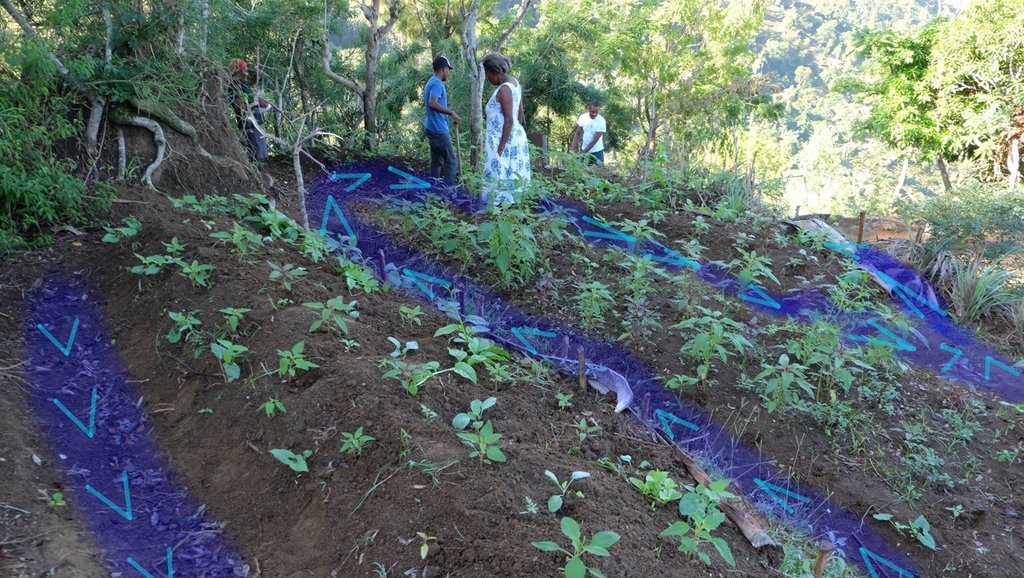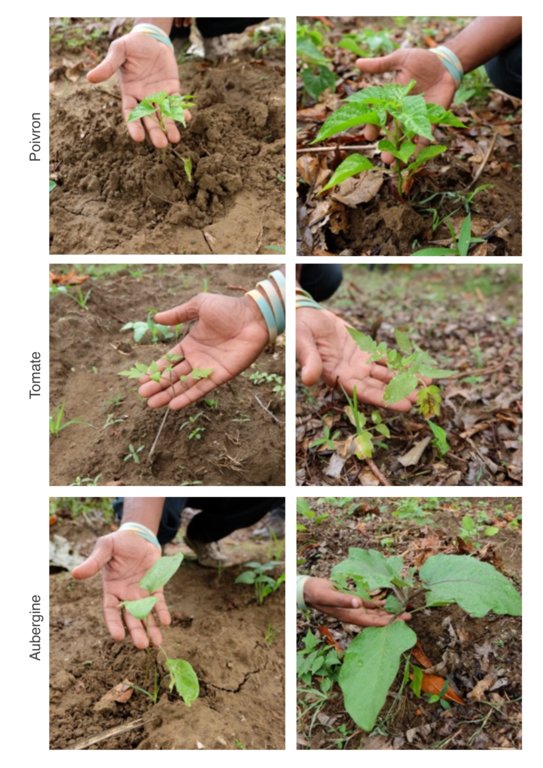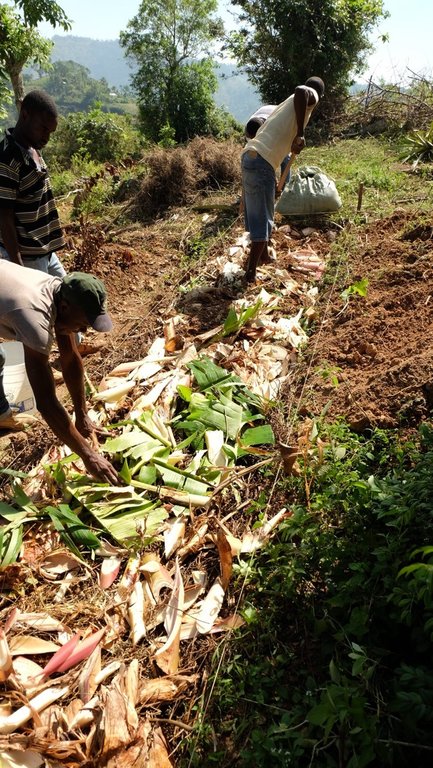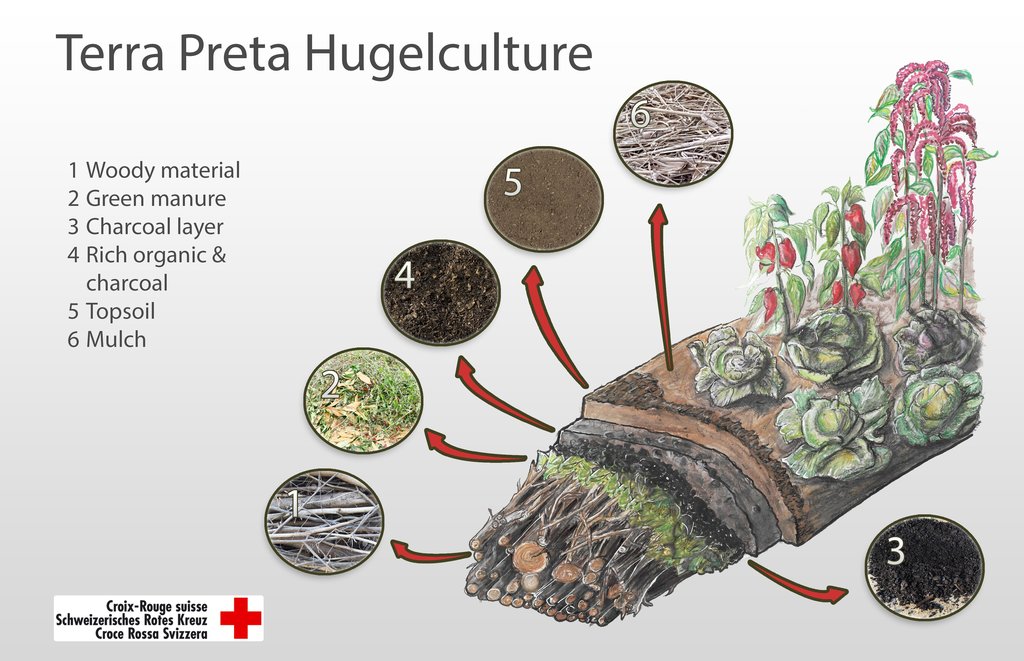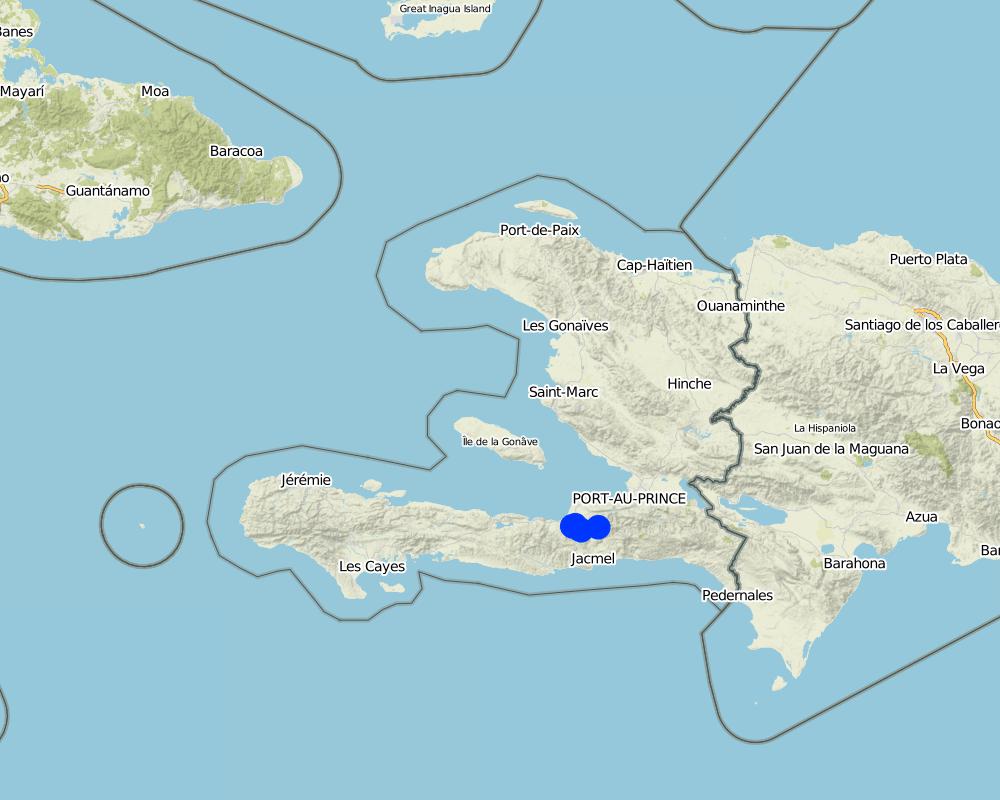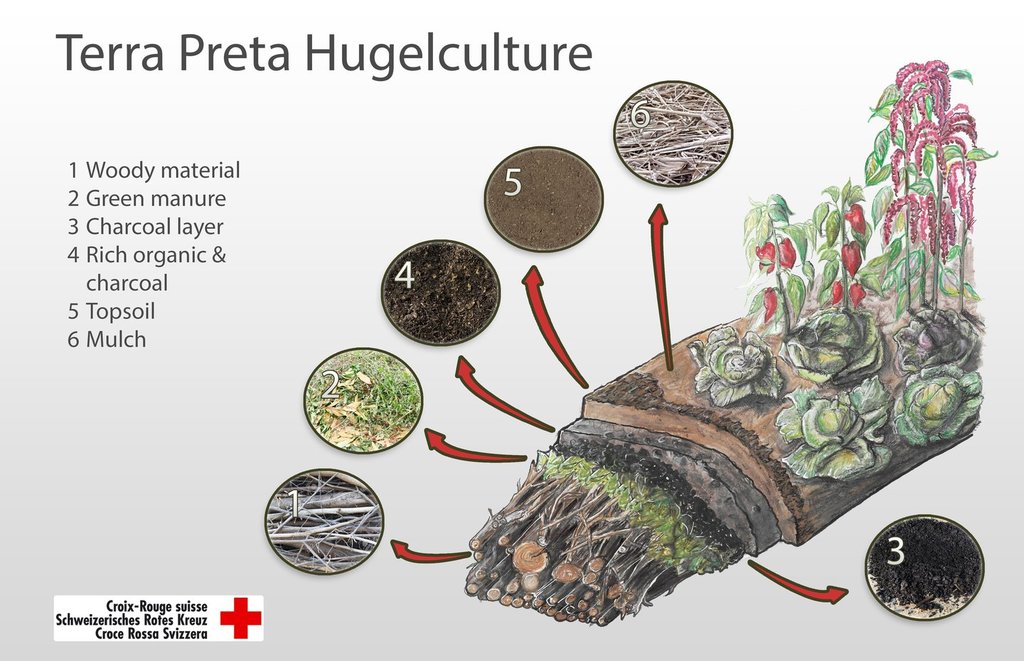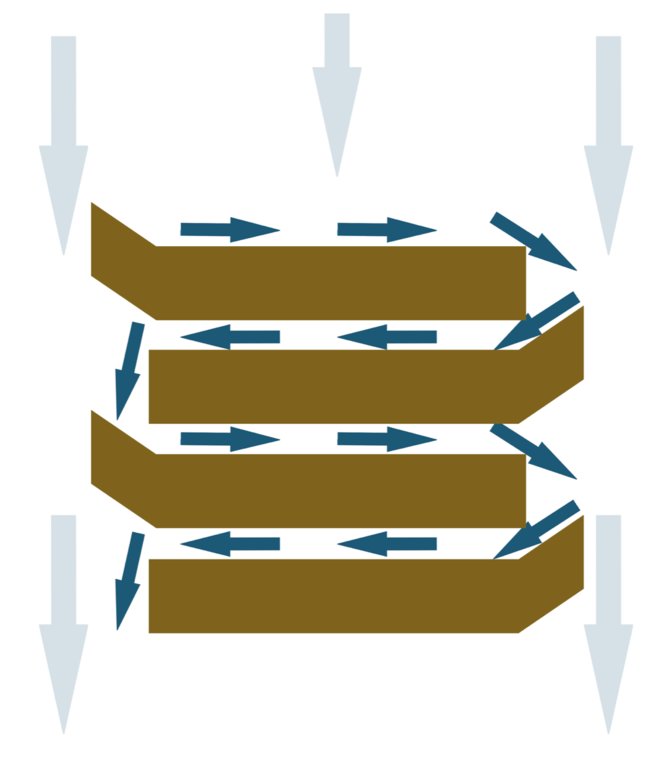Terra Preta raised garden beds [هايتي]
- تاريخ الإنشاء:
- تحديث:
- جامع المعلومات: Karl Harald Bier
- المحرر: Anton Jöhr
- المراجعون: David Beritault, Alexandra Gavilano
Jaden kolin, Tè mirak
technologies_935 - هايتي
عرض الأقسام
توسيع الكل طي الكل1. معلومات عامة
1.2 تفاصيل الاتصال بالأشخاص الرئيسيين لمصدر المعلومات والمؤسسات المشاركة في تقييم وتوثيق التقنية
اسم المشروع الذي سهّل توثيق/تقييم التقنية (إذا كان ذلك على صلة)
Book project: where people and their land are safer - A Compendium of Good Practices in Disaster Risk Reduction (DRR) (where people and their land are safer)اسم المؤسسة (المؤسسات) التي سهلت توثيق/تقييم التقنية (إذا كان ذلك على صلة)
Swiss Red Cross (Swiss Red Cross) - سويسرا1.3 الشروط المتعلقة باستخدام البيانات الموثقة من خلال WOCAT
يوافق جامع المعلومات والشخص (لاشخاص) الرئيسي لمصدر المعلومات على الشروط المتعلقة باستخدام البيانات الموثقة من خلال WOCAT:
نعم
1.4 إعلان بشأن استدامة التقنية الموصوفة
هل التقنية الموصوفة هنا تمثل مشكلة فيما يتعلق بتدهور الأراضي، بحيث لا يمكن إعلانها تقنية مستدامة لإدارة الأراضي؟:
كلا
1.5 الإشارة إلى الاستبيان (الاستبيانات) حول مناهج الإدارة المستدامة للأراضي (موثقة باستخدام WOCAT)
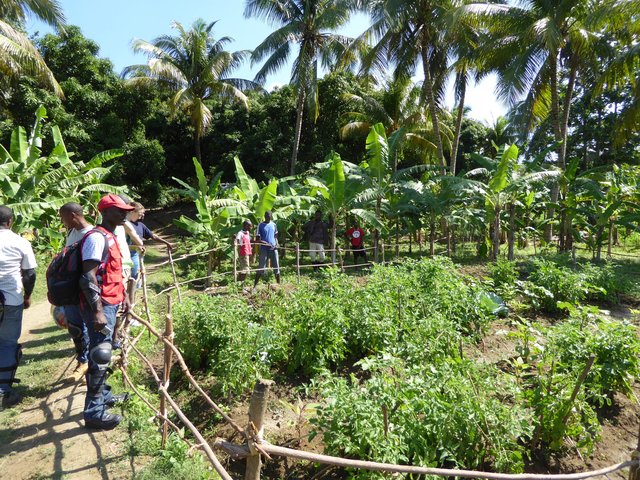
Approche au niveau ménage pour jardins Terra Preta [هايتي]
L'approche des jardins Terra Preta au niveau ménage, avec des jardins de démonstration crée avec des membres des Organisations Communautaires de Base (OCB), facilite la vulgarisation de la technologie Terra Preta parmi la population vulnérable des zones rurales de la commune de Léogâne, Haïti.
- جامع المعلومات: Helen Gambon
2. وصف تقنيةالإدارة المستدامي للأراضي
2.1 وصف مختصر للتقنية
تعريف التقنية:
Terra Preta raised garden beds are a combination of techniques from permaculture and the production of Terra Preta, an anthrosol. These garden beds, which were created with local resources, are highly fertile and enable the production of much higher yields than traditional techniques, while diminishing soil erosion.
2.2 وصف تفصيلي للتقنية
الوصف:
One of the major problems in the mountainous rural zones of the municipality of Léogâne in Haiti is the severe degradation and erosion of soils. The soil loss aggravates the vulnerable situation of the local population, mainly farmers. The Terra Preta raised garden beds were introduced in this region after the earthquake of 2010, and were replicated by several organisations and also by members of the communities. They are based on two main techniques:
1) Terra Preta is a technique to create soils based on a lacto-acidic fermentation of organic matter with charcoal powder. This technique was used by indigenous people in Amazonia, and rediscovered and replicated recently by scientists. The technique is characterised by the use of local resources and a high fertility. With this technique, a soil layer of several decimeters can be produced in a few years, whereas this takes normally around 100 years per centimeter. Soil analyses show that the formation of humic acids can be demonstrated after 4 months.
2) Raised garden beds (Hugelculture) are a technique from permaculture. Permaculture is a science of agricultural and social systems which uses the principles of ecology and the knowledge of traditional societies to simulate the diversity, stability and the resilience of natural ecosystems. Raised garden beds consist of an interior of ligneous material, covered by a layer of earth. The elevated construction facilitates the work in the garden and the decomposition of wood inside the beds. Due to their spongy structure, the raised garden beds function as a water reservoir during dry periods.
The garden beds are placed perpendicularly to the slope direction as much as possible, and are arranged alternately, with an extension to redirect the surface runoff towards the structures. This arrangement prevents the water from draining directly. This promotes the infiltration of water into the soil, where it is captured by the ligneous material, which prevents erosion (see the photograph).
The following inputs to the garden beds can be found locally:
- Organic matter: ligneous material, dry straw, fresh straw, harvest residues, organic residues rich in NPK (kitchen waste, animal waste, etc.),
- Charcoal powder (biochar),
- Possibly ashes or other fertile materials.
With these materials, which are generally without cost and locally available, a raised garden bed can be set up in less than an hour. Even without additional fertilisation after the set up, the technique offers the possibility to have several cycles of vegetable production. Experiments showed good results during 4 years of continuous plantation in Thozin (Grand Goâve). In order to secure soil fertility for many years, organic matter can be added after the period of plantation. It can be easily incorporated below the first layer of soil, and the decomposition takes place automatically. When put in place on sloping terrain, the garden beds slow down erosion strongly, and can serve to protect houses.
The technique is valued because of its cost-effectiveness and its sustainability compared to known techniques. The complexity of the implementation can be a limiting factor for an autonomous replication by the beneficiaries. That is when they see the set-up of the structures and think they know how to replicate it without taking account of all the details which are essential for the good functioning of the structures. This is why generally a certain level of support by technicians is required.
2.3 صور التقنية
2.5 البلد/المنطقة/المواقع التي تم تنفيذ التقنية فيها والتي يغطيها هذا التقييم
البلد:
هايتي
المنطقة/الولاية/المحافظة:
West department
مزيد من التفاصيل حول الموقع:
Municipality of Léogâne
حدد انتشار التقنية:
- يتم تطبيقها في نقاط محددة/ تتركز على مساحة صغيرة
Map
×2.6 تاريخ التنفيذ
في حالة عدم معرفة السنة بالتحديد، يرجى الإشارة إلى التاريخ التقريبي:
- منذ أقل من 10 سنوات (مؤخرًا)
2.7 إدخال التقنية
حدد كيف تم إدخال التقنية:
- من خلال المشاريع/ التدخلات الخارجية
3. تصنيف تقنية الإدارة المستدامي للأراضي
3.1 الغرض الرئيسي ( الأغراض الرئيسية) للتقنية
- تحسين الإنتاج
- الحد من تدهور الأراضي ومنعه وعكسه
- الحد من مخاطر الكوارث
- التخفيف من تغير المناخ وآثاره
- خلق أثر اقتصادي مفيد
- خلق أثر اجتماعي مفيد
3.2 نوع (أنواع) استخدام الأراضي الحالية حيث يتم تطبيق التقنية

الأراضي الزراعية
- زراعة سنوية
الزراعة السنوية - حدد المحاصيل:
- خضروات - اخرى
- الخضروات - الخضروات الورقية (السلطات، الملفوف، السبانخ، وغيرها)
- pepper, tomato, chili pepper
عدد مواسم الزراعة في السنة:
- 2
حدد:
The intervention zone has 2 cropping periods based on 2 rainy seasons. The Terra Preta raised garden beds are usually used all year round.
التعليقات:
Main crops (cash and food crops): Vegetables (for example pepper, cabbage, spinach, tomato, chili pepper)
With this technique, marginal land can be cultivated. The soil in place does not play a very important role because the nutrients are contained in the inputs.
3.3 هل تغير استخدام الأراضي نتيجة لتنفيذ التقنية؟
هل تغير استخدام الأراضي نتيجة لتنفيذ التقنية؟:
- نعم (يرجى ملء الأسئلة أدناه فيما يتعلق باستخدام الأراضي قبل تنفيذ التقنية)

أرض غير منتجة
حدد:
Degraded soils, sandy or inert substrates
ملاحظات:
The technology enables the production of vegetables on land that was not productive before (degraded soils, sandy or inert substrates). This allows farmers to diversify their traditional crops of maize, peas, sorghum and sweet potato with vegetables.
3.4 إمدادات المياه
إمدادات المياه للأرض التي يتم تنفيذ التقنية عليها:
- بعلية
3.5 مجموعةالإدارة المستدامة للأراضي التي تنتمي إليها هذه التقنية
- الإدارة المتكاملة لخصوبة التربة
- التدابير المتقاطعة للمنحدرات
- حدائق منزلية
3.6 التدابير التقنية في مجال إلادارة المستدامة للأراضي

التدابير الزراعية
- A2: المادة العضوية/خصوبة التربة
- A3: معالجة سطح التربة

التدابير البنيوية
- الحواجز والضفاف
3.7 الأنواع الرئيسية من تدهور الأراضي التي تناولتها التقنية

تآكل التربة بالمياه
- الوزن(Wt): فقدان التربة السطحية/تآكل السطح
- (Wg):الانجراف الخلجاني/ الخلجان

التدهور البيولوجي
- (Bl): فقدان الحياة بالتربة
3.8 منع أو حد أو عكس تدهور الأراضي
تحديد هدف التقنية فيما يتعلق بتدهور الأراضي:
- الحد من تدهور الأراضي
- اصلاح/إعادة تأهيل الأراضي المتدهورة بشدة
4. المواصفات الفنية، وأنشطة التنفيذ، والمدخلات، والتكاليف
4.1 الرسم الفني للتقنية
المواصفات الفنية (المتعلقة بالرسم الفني):
1. Terrain analysis:
The first step in the construction is the terrain analysis: what is the size of the terrain, the relief, the environment (vegetation, buildings, water courses) and which are the resources (water, biochar, vegetation, animals, organic residues) present in place? Specific needs and social aspects, the neighbourhood and land holdings must also be considered.
2. Elaborating a land use plan:
The second step is the elaboration of a land use plan: definition of the position of the garden beds, of the protection measures (against wind, sun and heat), and of the vegetables to grow.
3. Construction of the garden beds:
After the preparatory work, the actual construction of the garden beds begins.
- A trench of approximately 10 cm depth is dug (width of 1-1.20 m, length undefined),
- The ligneous materials (decomposing wood, of larger or smaller volume) are arranged to create a mound. Holes between the materials should be filled-up with earth.
- The organic matter is added in layers in the following order: dry straw, animal waste, pulse crops and organic matter rich in NPK.
- Charcoal powder can be added between the layers of rich organic matter, or even better, mixed with the latter.
- A layer of earth of approximately 10 cm is added as cover.
- During the process of construction, every layer should be watered.
The establishment of multiple garden beds is done as described in figure 2 above. The garden beds are installed in alternation with an extension to redirect the surface runoff towards the structures. The water is forced around the structures, which will facilitate the infiltration of the water and the deposition of sediments. As a result, the water is captured in the garden bed, and erosion is reduced. A more detailed description with illustrations is given below.
المؤلف:
Mariannina Oberhagen
التاريخ:
01/01/2017
4.2 معلومات عامة بخصوص حساب المدخلات والتكاليف
حدد كيفية احتساب التكاليف والمدخلات:
- لكل وحدة تقنية
حدد الوحدة:
isolated structure
حدد أبعاد الوحدة (إذا كانت ذات صلة):
width: 1.10 m; length: 10 m
عملة أخرى/ عملة وطنية (حدد):
Haiti Gourde
إذا كان ذا صلة، وضح سعر الصرف من الدولار الأمريكي إلى العملة المحلية (على سبيل المثال، 1 دولار أمريكي = 79.9 ريال برازيلي): 1 دولار أمريكي =:
68,0
اذكر متوسط تكلفة أجر العمالة المستأجرة في اليوم الواحد:
250
4.3 أنشطة التأسيس
| النشاط | التوقيت (الموسم) | |
|---|---|---|
| 1. | Outlining of raised garden beds | year-round |
| 2. | Collection of materials | year-round |
| 3. | Digging a basin along the contour | year-round, preferably at the start of the rainy season |
| 4. | Building the different layers (wood, dry straw, fresh straw, pulse crops and organic matter rich in NPK, earth, charcoal powder) | year-round, preferably at the start of the rainy season |
| 5. | Replanting of vegetable seedlings | year-round, preferably at the start of the rainy season |
| 6. | Watering | year-round, preferably at the start of the rainy season |
4.4 التكاليف والمدخلات اللازمة للتأسيس
| تحديد المدخلات | الوحدة | الكمية | التكاليف لكل وحدة | إجمالي التكاليف لكل مدخل | % من التكاليف التي يتحملها مستخدمو الأراضي | |
|---|---|---|---|---|---|---|
| العمالة | Skilled labour (technical support) | person-days | 0,5 | 3000,0 | 1500,0 | |
| العمالة | Unskilled labour (construction) | person-days | 1,0 | 250,0 | 250,0 | 100,0 |
| معدات | Tools (spade, pickaxe) | piece | 1,0 | 5,0 | 5,0 | 100,0 |
| المواد النباتية | Seedlings of cabbage | seedling | 10,0 | 10,0 | 100,0 | |
| المواد النباتية | Seedlings of spinach | seedling | 20,0 | 5,0 | 100,0 | |
| المواد النباتية | Seedlings of tomato | seedling | 10,0 | 5,0 | 50,0 | |
| مواد البناء | Decomposing wood | batch | 1,0 | 200,0 | 200,0 | 100,0 |
| مواد البناء | Earth | batch | 1,0 | 50,0 | 50,0 | 100,0 |
| مواد البناء | Dry straw | batch | 1,0 | 100,0 | 100,0 | 100,0 |
| مواد البناء | Fresh straw | batch | 1,0 | 100,0 | 100,0 | 100,0 |
| مواد البناء | Animal waste | Bag | 1,0 | 100,0 | 100,0 | 100,0 |
| مواد البناء | Charcoal/biochar | kg | 50,0 | 2,0 | 100,0 | 100,0 |
| إجمالي تكاليف إنشاء التقنية | 2655,0 | |||||
| إجمالي تكاليف إنشاء التقنية بالدولار الأمريكي | 39,04 | |||||
إذا تحمل مستخدم الأرض أقل من 100% من التكاليف، حدد من قام بتغطية التكاليف المتبقية:
Swiss Red Cross
التعليقات:
The land users have the necessary tools (5 HTG are budgeted to compensate for the use of their own tools). The construction materials are also locally available, and are generally considered as waste.
4.5 الصيانة/الأنشطة المتكررة
| النشاط | التوقيت/الوتيرة | |
|---|---|---|
| 1. | watering | 3 days |
| 2. | weeding | 2 weeks |
| 3. | mulching | 2 months |
| 4. | refertilisation | 5 years |
4.6 التكاليف والمدخلات اللازمة للصيانة/للأنشطة المتكررة (سنويًا)
| تحديد المدخلات | الوحدة | الكمية | التكاليف لكل وحدة | إجمالي التكاليف لكل مدخل | % من التكاليف التي يتحملها مستخدمو الأراضي | |
|---|---|---|---|---|---|---|
| العمالة | Annual maintenance | person-days | 15,0 | 250,0 | 3750,0 | 100,0 |
| معدات | Watering device | piece | 1,0 | 150,0 | 150,0 | 100,0 |
| المواد النباتية | Seed and seedlings | various | 1,0 | 250,0 | 250,0 | 100,0 |
| إجمالي تكاليف صيانة التقنية | 4150,0 | |||||
| إجمالي تكاليف صيانة التقنية بالدولار الأمريكي | 61,03 | |||||
التعليقات:
The indicated costs for the seed and the seedlings are the costs on the local market, but the land users reproduce these from existing plants, that they received from the project for the first implemented raised bed.
4.7 أهم العوامل المؤثرة على التكاليف
قدم وصفا لأهم العوامل التي تؤثر على التكاليف:
The labour (and the technical support for the first 3-4 structures of raised beds).
5. البيئة الطبيعية والبشرية
5.1 المناخ
هطول الأمطار السنوي
- < 250 مم
- 251- 500 ملم
- 501 - 750ملم
- 1,000-751 ملم
- 1,500-1,100 ملم
- 2,000-1,500 ملم
- 3,000-2,001 ملم
- 4,000-3,100 ملم
- > 4000 ملم
المواصفات/التعليقات على هطول الأمطار:
There is a dry season from December to February and a rainy season from April to October, with two peaks at the start and at the end of the period, and a relative pause in July.
المنطقة المناخية الزراعية
- شبه رطبة
5.2 طوبوغرافيا
متوسط الانحدارات:
- مسطح (0-2%)
- بسيط (3-5%)
- معتدل (6-10%)
- متدحرج (11-15%)
- تلال (16-30%)
- شديدة الانحدار(31-60%)
- فائقة الانحدار (>60%)
التضاريس:
- هضاب/سهول
- أثلام مرتفعة
- المنحدرات الجبلية
- منحدرات التلال
- منحدرات في السفوح
- قاع الوادي
المنطقة الارتفاعية:
- 100-0 متر فوق سطح البحر
- 500-101 متر فوق سطح البحر
- 1,000-501 متر فوق سطح البحر
- 1,500-1,001 متر فوق سطح البحر
- 2,000-1,501 متر فوق سطح البحر
- 2,500-2,100 متر فوق سطح البحر
- 3,000-2,501 متر فوق سطح البحر
- 4,000-3,001 متر فوق سطح البحر
- > 4000 متر فوق سطح البحر
وضح ما إذا كانت التقنية مطبقة على وجه التحديد في:
- غير ذات صلة
5.3 التربة
متوسط عمق التربة:
- ضحل جدًا (0-20 سم)
- ضحلة (21-50 سم)
- متوسطة العمق (51-80 سم)
- عميقة (81-120 سم)
- عميقة جدًا (> 120 سم)
قوام التربة (التربة السطحية):
- متوسط ( طميي، سلتي)
- ناعم/ثقيل (طيني)
قوام التربة (> 20 سم تحت السطح):
- خشن / خفيف (رملي)
المواد العضوية في التربة السطحية:
- منخفضة (<1%)
5.4 توافر المياه ونوعيتها
منسوب المياه الجوفية:
> 50 م
توافر المياه السطحية:
متوسط
نوعية المياه (غير المعالجة):
مياه الشرب سيئة (تتطلب معالجة)
هل تعتبر ملوحة الماء مشكلة؟:
كلا
هل تحدث فيضانات في المنطقة؟:
كلا
5.5 التنوع البيولوجي
تنوع الأنواع:
- متوسط
تنوع الموائل:
- منخفض
5.6 خصائص مستخدمي الأراضي الذين يطبقون التقنية
مستقر أو مرتحل:
- غير المترحل
التوجه السوقي لنظام الإنتاج:
- الكفاف (الإمداد الذاتي)
الدخل من خارج المزرعة:
- أقل من % 10من كامل الدخل
المستوى النسبي للثروة:
- ضعيف جدا
أفراداً أو مجموعات:
- فرد/أسرة معيشية
مستوى المكننة:
- عمل يدوي
الجنس:
- نساء
- رجال
عمر مستخدمي الأرضي:
- متوسط العمر
- كبار السن
5.7 متوسط مساحة الأرض التي يستخدمها مستخدمو الأراضي الذين يطبقون التقنية
- < 0.5 هكتارا
- 0.5 - 1 هكتار
- 1 -2 هكتار
- 2 - 5 هكتار
- 5 - 15 هكتار
- 15 - 50 هكتار
- 50 - 100هكتار
- 500-100 هكتار
- 1,000-500 هكتار
- 10,000-1,000 هكتار
- > 10,000 هكتار
هل يعتبر هذا نطاقًا صغيرًا أو متوسطًا أو واسعا (في إشارة إلى السياق المحلي)؟:
- على نطاق صغير
5.8 ملكية الأراضي، وحقوق استخدام الأراضي، وحقوق استخدام المياه
ملكية الارض:
- فردية، لا يوجد سند ملكية
- فردية، يوجد سند ملكية
حقوق استخدام الأراضي:
- فردي
حقوق استخدام المياه:
- وصول مفتوح (غير منظم)
- فردي
5.9 الوصول إلى الخدمات والبنية التحتية
الصحة:
- ضعيف
- معتدل
- جيد
التعليم:
- ضعيف
- معتدل
- جيد
المساعدة التقنية:
- ضعيف
- معتدل
- جيد
العمل (على سبيل المثال خارج المزرعة):
- ضعيف
- معتدل
- جيد
الأسواق:
- ضعيف
- معتدل
- جيد
الطاقة:
- ضعيف
- معتدل
- جيد
الطرق والنقل:
- ضعيف
- معتدل
- جيد
مياه الشرب وخدمات الصرف الصحي:
- ضعيف
- معتدل
- جيد
الخدمات المالية:
- ضعيف
- معتدل
- جيد
6. الآثار والتصريحات الختامية
6.1 الآثار التي أظهرتها التقنية في الموقع
الآثار الاجتماعية والاقتصادية
الإنتاج
إنتاج المحاصيل
الكمية بعد الإدارة المستدامة للأراضي:
an increase of yields by 2-3 times
التعليقات/ حدد:
The yield usually increases 2-3 times with the introduction of the technique.
جودة المحاصيل
التعليقات/ حدد:
The crops are more healthy and more resistant to diseases. The quality of the vegetables is better, and clients on the market of Grand Goâve pay more for the products from Terra Preta.
تنوع المنتج
التعليقات/ حدد:
The majority of persons in the area are not used to vegetable growing. The technique makes it possible to grow vegetables which increase the nutritional basis (rice, pearl millet, sweet potato and peas).
منطقة الإنتاج
التعليقات/ حدد:
Normally, the soils are not used for crop production. Through the technique production area is created. In addition, the surface increases through the undulated shape of the garden beds.
الآثار الايكولوجية
دورة المياه / الجريان السطحي
كمية المياه
التعليقات/ حدد:
a) The infiltration of water in the soil is facilitated.
b) The water is retained by the organic matter in the garden beds (especially by the decomposing wood).
الجريان السطحي
التربة
رطوبة التربة
تراكم التربة
التعليقات/ حدد:
Water erosion is slowed down by the garden beds, and the sediments are deposited in front of these. However, the size of the garden beds is limited, and in order to combat erosion on a larger scale additional measures must be considered, like vegetated barriers or terracing.
تراص التربة
المادة العضوية في التربة/تحت الطبقة c
التعليقات/ حدد:
Soil analyses
sample 1: 0.93%- >3.50%
sample 2: 2.04% - >5.51%
الحد من مخاطر المناخ والكوارث
آثار الجفاف
التعليقات/ حدد:
In the dry periods, the technique permits to continue crop production during several weeks without irrigation.
انبعاث الكربون والغازات المسببة للاحتباس الحراري
التعليقات/ حدد:
Sequestered in the soil by the charcoal and the organic matter (especially the ligneous material).
6.2 الآثار التي أظهرتها التقنية خارج الموقع
توافر المياه
الضرر على البنية التحتية العامة/ الخاصة
6.3 تعرض التقنية وحساسيتها لتغير المناخ التدريجي والظواهر المتطرفة/الكوارث المرتبطة بالمناخ (كما يراها مستخدمو الأراضي)
الظواهر المتطرفة / الكوارث المرتبطة بالمناخ
الكوارث الجوية
| كيف تتعامل التقنية مع ذلك؟ | |
|---|---|
| عاصفة إستوائية | باعتدال |
| عاصفة ممطرة محلية | جيدة جدا |
| عاصفة رعدية محلية | جيدا |
6.4 تحليل التكلفة والعائد
كيف يمكن مقارنة العوائد نسبة لتكاليف الإنشاء (من وجهة نظر مستخدمي الأراضي)؟
عوائد قصيرة الأجل:
ايجابي جدا
عوائد طويلة الأجل:
ايجابي جدا
كيف تتم مقارنة العوائدمع كلفة الصيانة/التكاليف المتكررة (من وجهة نظر مستخدمي الأراضي)؟
عوائد قصيرة الأجل:
ايجابي جدا
عوائد طويلة الأجل:
ايجابي جدا
6.5 اعتماد التقنية
- 1-10%
إذا كان متاحًا، قم بتحديد الكمية (عدد الأسر المعيشية و/أو المساحةالمغطاة):
>300 households
من بين جميع الذين تبنوا التقنية، كم عدد الذين فعلوا ذلك بشكل تلقائي، أي دون تلقي أي حوافز مادية/مدفوعات؟:
- 51-90%
التعليقات:
Small quantities of seed were given.
6.6 التكيف
هل تم تعديل التقنية مؤخرًا لتتكيف مع الظروف المتغيرة؟:
كلا
6.7 نقاط القوة / المزايا / الفرص التي توفرها التقنية
| نقاط القوة/ المزايا/ الفرص من وجهة نظر مستخدمي الأراضي |
|---|
| Strongly increased yield |
| Improved product quality (size, taste) |
| Shortened crop cycle |
| نقاط القوة/ المزايا/ الفرص من وجهة نظر جامع المعلومات أو غيره من الاشخاص الرئيسيين لمصدر المعلومات |
|---|
| Increased production (several times) |
| Improved nutrition |
| Income generation for the farmers |
| Shortened production cycle |
6.8 نقاط ضعف / مساوىء / مخاطر التقنية وسبل التغلب عليها
| نقاط الضعف/ المساوىء/ المخاطر من وجهة نظر مستخدم الأراضي | كيف يمكن التغلب عليها؟ |
|---|---|
| More work than traditional techniques. The latter are focused on agricultural production in fields (maize, pearl millet, sweet potato, peas/beans), and require considerably less daily maintenance. | By having the gardens close to the house for follow-up and support. |
| نقاط الضعف/ المساوىء/ المخاطر من وجهة نظر جامع المعلومات أو غيره من الاشخاص الرئيسيين لمصدر المعلومات | كيف يمكن التغلب عليها؟ |
|---|---|
| Complexity of the technique | Regular education, follow-up and continuous support |
7. المراجع والروابط
7.1 طرق جمع/مصادر المعلومات
- زيارات ميدانية، مسوحات ميدانية
80
- مقابلات مع مستخدمي الأراضي
30
- مقابلات مع المتخصصين/الخبراء في الإدارة المستدامة للأراضي
D. Buchon, external consultant
متى تم تجميع البيانات (ميدانيا)؟:
08/12/2016
7.2 المراجع للمنشورات المتاحة
العنوان، المؤلف، السنة، النظام القياسي الدولي لترقيم الكتب ISBN:
Terra Preta: Production. Guide des méthodes de la production de Terra Preta dans les jardins potagères. Karl Harald Bier. 2013.
متاح من أين؟كم التكلفة؟:
Welthungerhilfe
العنوان، المؤلف، السنة، النظام القياسي الدولي لترقيم الكتب ISBN:
Pas de la mise en place d'un Jardin Colline TP. Karl Harald Bier. Swiss Red Cross
متاح من أين؟كم التكلفة؟:
info@redcross.ch
7.3 روابط للمعلومات ذات الصلة على الإنترنت
العنوان/الوصف:
Terra Preta - Charbon bio - Climatefarming, Hans-Peter Schmidt, 2008, ISSN 1663-0521
عنوان الرابط URL:
http://www.ithaka-journal.net/climatefarming-fr1?lang=fr
الروابط والوحدات المواضيعية
توسيع الكل طي الكلالروابط

Approche au niveau ménage pour jardins Terra Preta [هايتي]
L'approche des jardins Terra Preta au niveau ménage, avec des jardins de démonstration crée avec des membres des Organisations Communautaires de Base (OCB), facilite la vulgarisation de la technologie Terra Preta parmi la population vulnérable des zones rurales de la commune de Léogâne, Haïti.
- جامع المعلومات: Helen Gambon
الوحدات المواضيعية
لا يوجد وحدات مواضيعية



